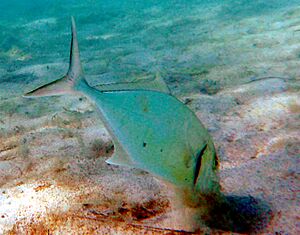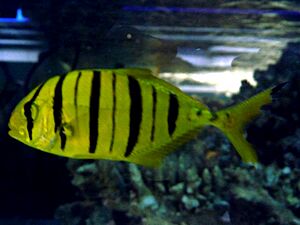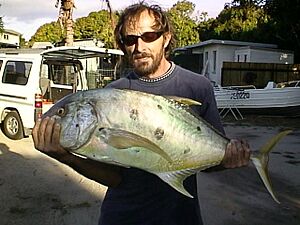Golden trevally facts for kids
Quick facts for kids Golden trevally |
|
|---|---|
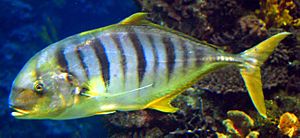 |
|
| Conservation status | |
| Scientific classification | |
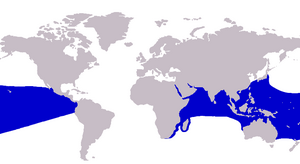 |
|
| Approximate range of the golden trevally | |
| Synonyms | |
|
Scomber speciosus Forsskål, 1775 |
The golden trevally (Gnathanodon speciosus) is a large ocean fish. It is also known as the golden kingfish, banded trevally, or king trevally. This fish belongs to the jack and horse mackerel family, called Carangidae. It is the only member of its special genus called Gnathanodon.
Golden trevallies live in warm, tropical and subtropical waters. You can find them in the Indian Ocean and the Pacific Ocean. Their home stretches from South Africa all the way to Central America. They also live as far north as Japan and as far south as Australia. These fish mostly stay close to shore. They live near reefs and on sandy bottoms.
It is easy to tell a golden trevally apart from other fish. They have thick, rubbery lips and special colors. Young fish are bright yellow with black stripes. As they grow up, they turn a shiny golden-silver color. Golden trevallies can grow up to 120 cm (about 4 feet) long and weigh 15 kg (about 33 pounds).
Young golden trevallies swim in schools. They often follow bigger things like sharks and even jellyfish. This fish uses its special mouth to suck up food from the sand or reef. They eat small fish, crustaceans (like shrimp and crabs), and molluscs. People in some parts of the Middle East catch a lot of golden trevallies for food. They are also popular for fishing and are raised in fish farms. Young golden trevallies are also popular in marine aquaria because of their bright colors.
Contents
About the Golden Trevally
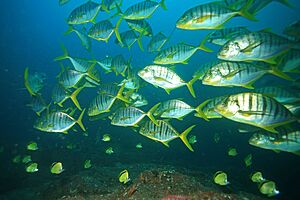
The golden trevally is the only fish in its unique group, or genus, called Gnathanodon. This genus is part of the larger jack and horse mackerel family, Carangidae.
Naming the Golden Trevally
A Swedish scientist named Peter Forsskål first described this fish in 1775. He first called it Scomber speciosus. The word speciosus is Latin for "beautiful." Later, a Dutch fish expert named Pieter Bleeker gave it its own genus, Gnathanodon. This name means "toothless jaws" in Latin. This is because older golden trevallies do not have teeth on their jaws.
People often call this fish by names that describe its look. These names include 'golden trevally', 'banded trevally', and 'king trevally'. In Hawaii, smaller ones are called 'papio'.
Where Do Golden Trevallies Live?
Golden trevallies live in warm, tropical and subtropical waters. You can find them in the Indian Ocean and the Pacific Ocean. In the Indian Ocean, they live along the east African coast, including the Red Sea. They also live near India, Southeast Asia, and northern Australia. You can find them around islands like Madagascar and the Maldives.
In the Pacific Ocean, they are found from China and Japan down to eastern Australia and New Zealand. They also live around many central Pacific Islands, like Hawaii. Their range goes all the way to Central America.
Their Home in the Ocean
Golden trevallies mostly live in shallow waters near the coast. They can be found near rocky areas and coral reefs. They also live on open sand flats where they search for food. They seem to like clear water. This means you do not often see them in muddy estuaries. However, some have been found in shallow mangrove swamps looking for food.
What Does a Golden Trevally Look Like?
The golden trevally is a fairly large fish. It can grow up to 120 cm (about 4 feet) long and weigh 15.0 kg (about 33 pounds). Its body is flat and long, like most other trevallies. The top part of its body is a bit more curved than the bottom.
Special Mouth and Fins
One of the most special things about this fish is its mouth. It is very flexible and fleshy. When golden trevallies are bigger than 90 mm, they do not have any teeth on their jaws or tongue. Smaller ones have tiny teeth.
Their dorsal fin (on their back) has two parts. The anal fin (on their belly) has two separate spines. The pelvic fin is also on their belly. They have scales all over their chest.
Changing Colors
The golden trevally's color is what makes it famous. Young fish are bright golden yellow. They have 7 to 11 black stripes going up and down their body. These stripes are usually wide and narrow, one after another. The tips of their caudal fin (tail fin) are dark. They also have a clear black edge on their gill cover.
As the fish gets older, its body turns more silver or silvery-golden. The black stripes start to fade away or disappear completely. Sometimes, dark spots take their place. Their fins stay yellow, but they might have a bit of green. The dark edge on their gill cover also fades as they get older.
Golden Trevally Life and Habits
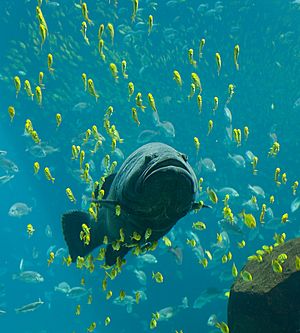
Adult golden trevallies can be found alone or in small schools. Young golden trevallies form bigger schools. They often swim very close to larger fish like groupers, sharks, and even jellyfish. This behavior is like that of the pilot fish. By staying close to these bigger animals, the young trevallies are safer from other fish that might want to eat them. Sometimes, they even follow scuba divers!
What Do They Eat?
The golden trevally is a daytime hunter. Unlike other fish in its family, it does not usually chase after single prey. It uses its special mouth to form a tube. This tube helps it suck food out of reefs and sandy areas. When it sucks up sand, it filters out the food. The sand is spit out, and the small creatures are swallowed.
They eat many different things. This includes crustaceans like shrimp, crabs, and small amphipods. They also eat molluscs and small fish. Some golden trevallies found in mangrove swamps ate only fish, which means they can also actively hunt.
Reproduction and Life Cycle
Golden trevallies reproduce at different times of the year. In Hawaii, they lay eggs from late February to early October. The busiest time is from late April to early September. They usually lay eggs in the evening and at night. In the Persian Gulf, they lay eggs in April and May. Young fish then join the local fishery in September and October.
Golden Trevallies and Humans
People have been eating golden trevallies for a very long time. Old sites in the United Arab Emirates show that people ate this fish even in prehistory. Today, people in the Pacific Islands still catch them using old methods like nets and spears.
On a larger scale, fishing boats catch them with gill nets. Countries like the UAE, Qatar, and Bahrain catch a lot of golden trevallies. Australia and Singapore catch some too. Between 2000 and 2010, the world caught between 1187 and 3475 t of golden trevally each year. Some countries like Singapore, Taiwan, Malaysia, and Indonesia also raise golden trevallies in fish farms.
Fishing for Golden Trevally
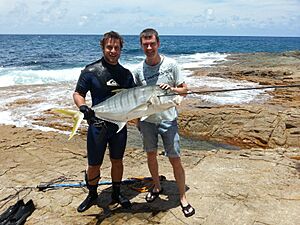
Golden trevallies are popular with both anglers (people who fish with a rod) and spearfishermen. They are considered a fun fish to catch. You can catch them with different baits and lures. They can be caught from the shore or from boats, making them easy to reach. Popular baits include prawns and small fish.
They are known to follow a burley (fish food) trail right up to a boat. This makes them easy to catch. Anglers use different lures like jigs, poppers, and minnows. Saltwater fly fishing has also become popular for catching golden trevally, especially in shallow, sandy areas. Once hooked, golden trevallies put up a strong fight.
Many people think golden trevallies are one of the best fish in the trevally family to eat. Their fresh meat is slightly clear and pink. When cooked, it turns white and juicy. It has a rich, tangy fish flavor.
Golden Trevallies as Pets
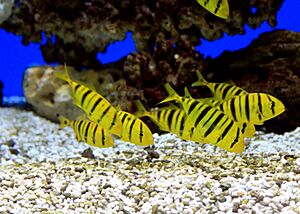
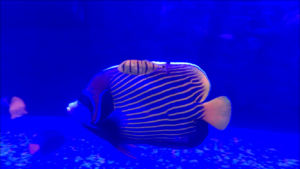
Young golden trevallies are often kept in marine aquaria (fish tanks). This is because of their bright yellow color and black stripes. Larger ones are also kept in bigger tanks. Scientists in Singapore have even figured out how to raise them in labs for the aquarium trade.
See also
 In Spanish: Gnathanodon speciosus para niños
In Spanish: Gnathanodon speciosus para niños



